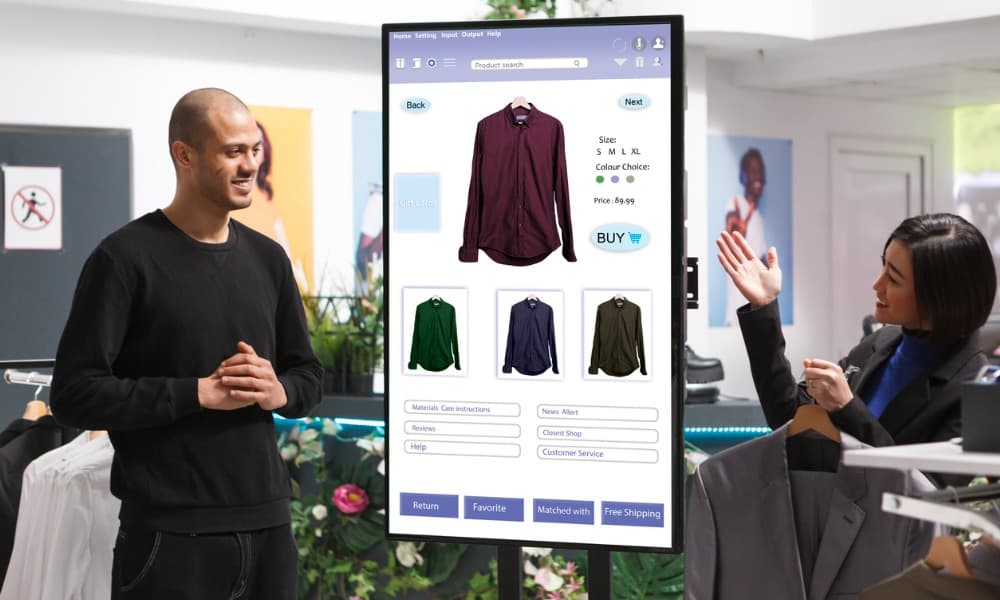Discover how to effectively engage the digital generation and stay ahead of the technology curve.
Key takeaways:- The digital signage industry is shifting from HD towards vivid ultra-high-definition (UHD) displays.
- Advancements in LED technology allow customized interactive experiences with unique shapes that mesh with architectural spaces.
- Interactive kiosks provide many exciting capabilities, including multitouch and facial and gesture controls.
- To sustainably increase brand understanding and business visibility, LED and OLED displays are the way forward. Low maintenance, energy efficiency, and visual impact make them a win-win.
The rise of HD digital signage
One major trend in digital signage is the move toward ultra-high-definition (UHD) displays that deliver stunning, pixel-free, ergonomic viewing. UHD, also known as 4K, provides four times more detail than full HD without any display lag. This allows screens to display life-like imagery that instantly grabs attention and treats viewers to immersive and memorable experiences. Many forward-thinking companies have already switched to 4K displays to stay ahead of the curve. Join them. As tablets and smartphones become more prevalent, integrating social media platforms and mobile devices into your platform is critical to delivering fully omnichannel messaging. Multi-channel integration leverages user-generated content from platforms like X or Instagram and drive engagement with digital signage displays. It also enables customers to interact with your brand through loyalty program or promotional content accessible directly on their devices.Immersive experiences with video walls
Video walls have reached an inflection point with recent LED manufacturing and video-processing advances. They are no longer restricted to rectangles or squares; they can bend to fit around corners and columns and seamlessly integrate into architecture. Beyond shape flexibility, LED video walls also feature better pixels with higher refresh rates, increased contrast ratio, and expanded color gamut. Higher color quality and innovations like chip-on-board technology and transparent substrates open up several opportunities for new applications. In corporate settings, LED video walls provide impressive visual communication for boardrooms, conferences, and presentations. They enable impactful messaging, collaboration, and information sharing within the workplace. In the retail and hospitality sector, LED video walls grab attention, convey information, promote products, enhance brand experiences, and create immersive environments that engage customers.Interactive kiosks: beyond the touchscreen
Interactive kiosks serve a multi-faceted role by providing an accessible, intuitive platform for users to access essential services and information. These devices set a new standard of service delivery across the transportation, retail, healthcare, and hospitality industries, among other, where they facilitate product/menu ordering, check-ins, ticketing, reservations, wayfinding, and self-service checkouts. Modern digital kiosks provide many capabilities to be excited about, including the following:- Multi-touch technology provides more flexibility in the structure of kiosk applications by allowing users to control simultaneous movements from multiple points of onscreen contact. A single user can control the kiosk while others may use the kiosk at the same time.
- Facial recognition technology uses facial features for verification and identification. High-resolution cameras scan a user’s face when they approach the kiosk, then software algorithms compare the image with a database of facial templates or stored images. If an exact match is found, the kiosk performs the desired transaction, grants access, or any other function. This eliminates the need for manual data entry or physical tokens, delivering faster, secure, and convenient services that drive customer loyalty.
- Gesture control interfaces use depth and motion sensors to capture and interpret human movements. Users can operate kiosks using mid-air gestures without touching the screen. This provides a fun and engaging way for users to interact with your products or services. Input is faster than a touchscreen kiosk; movements are tracked in real-time. Transmission of bacteria is also reduced and people who are apprehensive about using public shared surfaces feel more comfortable using the kiosk.
